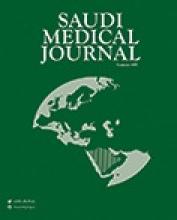To the Editor
I read with interest the recent case report by Alherabi et al1 on the treatment of a desmoid tumor (fibromatosis) of the head and neck. I was surprised at the reported treatment of this 42-year-old female patient. Although the authors are aware of the appropriate management, as stated in their report with supporting references, I wonder why this treatment was not applied in this case. My observations regarding management are:
1) A small remnant of the desmoid tumor was left behind at the time of surgery, and histopathological examination of the excised desmoid tumor showed one site with a positive tumor at the excision margin (a residual tumor grossly intra-operatively and on histo-pathological examination). The patient did not receive post-operative external beam radiotherapy, although they state that it should be given when there is residual tumor left behind. In the introductory paragraph, they indicate the possibility of adding external beam radiotherapy to surgery even in those with complete tumor excision and negative resection margins histopathologically because of the characteristics of desmoid tumors and their tendency to recur.
2) At 16 months follow up, the authors used the term ‘unfortunate’ when the residual tumor grew large enough to be identified however, this is expected for a residual tumor left behind that did not receive treatment with external beam radiation.
3) Then, and only then, 16 months following the surgery was external beam radiotherapy instituted, when I believe it should have been more appropriately given postoperatively to deal with the residual tumor.
4) Not surprisingly, 2-years after this delayed external beam radiotherapy course, the tumor regressed, but did not resolve.
5) When the residual tumor became large enough to make its presence identifiable 16 months following surgery, no biopsy and histopathological examination were performed, and radiation was administered.
Despite the management of this particular case, the authors report that surgery is usually followed by radiation therapy for the control of residual disease referencing the paper of Hosalkar et al.2 They also refer to the paper of Nuyttens et al,3 which is a review of 22 articles showing 75% tumor control when adjuvant radiotherapy is administered after surgery for a positive tumor margin, compared with only 41% tumor control if surgery alone is performed. My question remains as to why the authors did not follow the principles of desmoid tumor management in this instance.
Reply from the Author
I read with interest the comments from Dr. Hazim Barnouti from Baghdad, Iraq regarding our recently published case report.1 The respected doctor seems a supporter of solo management of such cases. In our institution, a quarterly 1000 bed medical center mainly focused in oncology, all decision making is carried out in a special clinic entitled “Combined Head & Neck Clinic”, which is membered by a Head & Neck surgeon, maxillofacial surgeon, medical oncologist, and radiation oncologist. It is well known in advanced centers that when faced with this rare disease, for which there are no clear guidelines, you refer to the best evidence available adding to that a respect for the individual patient’s wishes, and the morbidity of the treatment.
Although, the patient was only operated at 16 months post operatively, she had regular follow-ups with serial imaging, which all were supportive of stable disease. As this tumor is a known benign disease, there is evidence from some studies that did not show the effectiveness of adjuvant radiotherapy for the tumor with microscopically positive margins.4,5 A study by Kofoed et al6 in which they treated 15 patients; none were offered radiotherapy. Another study by Markhede et al7 treated only 3 patients out of 42 patient with adjuvant radiotherapy.
I advise my colleague to understand that in the complex medical and surgical field, especially for rare diseases, there is no one right answer. There are multiple right answers that need to fit to the individual patient rather than simply generalizing one idea.
Ameen Alherabi
Department of Otolaryngology-Head and Neck Surgery, Umm Al-Qura University, Makkah, Kingdom of Saudi Arabia
SAUDI MED J is now available in PubMed Central
We are pleased to announce that Saudi Medical Journal is now indexed by PubMed Central
PubMed Central (PMC) is a free full-text archive of biomedical and life sciences journal literature at the U. S. National Institutes of Health’s National Library of Medicine (NIH/NLM)
Articles are available in different formats (HTML, PDF, EPub)
Submit your article now for enhanced visibility and accessibility at:
E-mail: smjadmin{at}psmmc.med.sa
- Copyright: © Saudi Medical Journal
This is an open-access article distributed under the terms of the Creative Commons Attribution-Noncommercial-Share Alike 3.0 Unported, which permits unrestricted use, distribution, and reproduction in any medium, provided the original work is properly cited.






